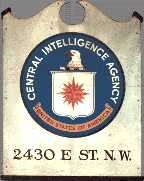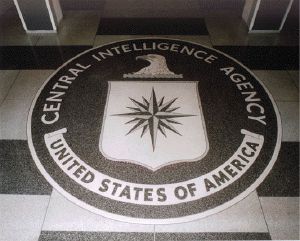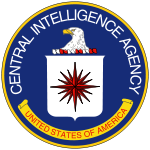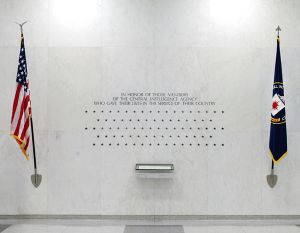Central Intelligence Agency
| Central Intelligence Agency CIA | |
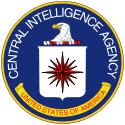 Seal of the Central Intelligence Agency | |
| Agency overview | |
|---|---|
| Formed | July 26, 1947 |
| Preceding Agency | Central Intelligence Group |
| Headquarters | Langley, Virginia, United States |
| Employees | Classified |
| Annual Budget | Classified |
| Minister Responsible | John Michael McConnell, Director of National Intelligence |
| Agency Executives | General Michael Hayden USAF, Director Stephen Kappes, Deputy Director Michael Morell, Associate Deputy Director |
| Website | |
| www.cia.gov | |
| Footnotes | |
| [1][2][3][4] | |
The Central Intelligence Agency(CIA) is an intelligence agency of the United States government. Eastablished in 1946, its first function is obtaining and analyzing information about foreign governments, corporations, and persons. Its second function is propaganda and public relations. Its third function is as the government's hidden hand via covert operations at the direction of the President and under oversight by Congress. This last role has caused much controversy for the CIA, raising questions about the legality, morality, and effectiveness of such operations.
CIA headquarters is in the community of Langley in the McLean CDP of Fairfax County, Virginia, a few miles northwest from downtown Washington, D.C. along the Potomac River. The CIA is part of the U.S. Intelligence Community, led by the Director of National Intelligence (DNI). The role and functions of the CIA are roughly equivalent to those of the United Kingdom's Secret Intelligence Service (MI6), the Canadian Security Intelligence Service (CSIS), the Australian Secret Intelligence Service (ASIS), and Israel's Mossad.
The CIA is sometimes referred to euphemistically in government and military parlance as Other Government Agencies (or OGA), particularly when its operations in a particular area are an open secret.
History
The Central Intelligence Agency was created by Congress with passage of the National Security Act of 1947, signed into law by President Harry S. Truman. It is the descendant of the Office of Strategic Services (OSS) of World War II, which was dissolved in October 1945 and its functions transferred to the State and War Departments. But the need for a centralized postwar intelligence-gathering operation was clearly recognized. Eleven months earlier, in 1944, William J. Donovan (a.k.a. Wild Bill Donovan), the OSS's creator, proposed to President Franklin D. Roosevelt creating a new espionage organization directly supervised by the President: "which will procure intelligence both by overt and covert methods and will at the same time provide intelligence guidance, determine national intelligence objectives, and correlate the intelligence material collected by all government agencies."
Under Donovan's plan, a powerful, centralized civilian agency would have coordinated all the intelligence services. He also proposed that this agency have authority to conduct "subversive operations abroad," but "no police or law enforcement functions, either at home or abroad."
Despite opposition from the military establishment, the State Department and the Federal Bureau of Investigation (FBI), President Truman established the Central Intelligence Group in January 1946. Later, under the National Security Act of 1947 (effective September 18, 1947), the National Security Council and the Central Intelligence Agency were established. Rear Admiral Roscoe H. Hillenkoetter was appointed as the first Director of Central Intelligence.
The now declassified National Security Council Directive on Office of Special Projects, June 18, 1948 (NSC 10/2) provided the operating instructions for the CIA:
- Plan and conduct covert operations which are conducted or sponsored by this government against hostile foreign states or groups or in support of friendly foreign states or groups but which are so planned and conducted that any US Government responsibility for them is not evident to unauthorized persons and that if uncovered the US Government can plausibly disclaim any responsibility for them. Covert action shall include any covert activities related to: propaganda; economic warfare; preventive direct action, including sabotage, anti-sabotage, demolition, and evacuation measures; subversion against hostile states, including assistance to underground resistance movements, guerrillas and refugee liberation groups, and support of indigenous anti-Communist elements in threatened countries of the free world.
In 1949, the Central Intelligence Agency Act (Public Law 81-110) was passed, permitting the agency to use confidential fiscal and administrative procedures, and exempting it from most of the usual limitations on the use of Federal funds. The act also exempted the CIA from having to disclose its "organization, functions, officials, titles, salaries, or numbers of personnel employed." It also created the program "PL-110," to handle defectors and other "essential aliens" who fall outside normal immigration procedures, as well as giving those persons cover stories and economic support.
During the first years of its existence, other branches of government did not exercise much control over the Central Intelligence Agency; justified by the desire to match and defeat KGB actions throughout the globe, a task many believed could be accomplished only through an approach as equally ungentlemanly as the KGB's, consequently, few in government closely inquired about the CIA's activity. The rapid expansion of the CIA, and a developed sense of independence under the Director of Central Intelligence (DCI) Allen Dulles added to this trend.
Things came to a head in the early 1970s, around the time of the Watergate political burglary affair. A dominant feature of political life during that period were the attempts of Congress to assert oversight of U.S. Presidency, the executive branch of the U.S. Government. Revelations about past CIA activities, such as assassinations and attempted assassinations of foreign leaders, illegal domestic spying on U.S. citizens, provided the opportunities to execute Congressional oversight of U.S. intelligence operations.
Hastening the Central Intelligence Agency's fall from grace were the burglary of the Watergate headquarters of the Democratic Party by ex-CIA agents, and President Nixon's subsequent use of the CIA to impede the FBI's investigation of the burglary. In the famous "smoking gun" audio tape provoking President Nixon's resignation, Nixon ordered his chief of staff, H.R. Haldeman, to tell the CIA that further investigation of Watergate would "open the whole can of worms" about the Bay Of Pigs of Cuba, and, therefore, that the CIA should tell the FBI to cease investigating the Watergate burglary, due to reasons of "national security".
In 1973, then-DCI James R. Schlesinger commissioned reports — known as the "Family Jewels" — on illegal activities by the Agency. In December 1974, Investigative journalist Seymour Hersh broke the news of the "Family Jewels" in a front-page article in the New York Times, revealing that the CIA had assassinated foreign leaders, and had conducted surveillance on some 7,000 American citizens involved in the antiwar movement (Operation CHAOS).
Congress responded to the disturbing charges in 1975, investigating the CIA in the Senate via the Church Committee, chaired by Senator Frank Church (D-Idaho), and in the House of Representatives via the Pike Committee, chaired by Congressman Otis Pike (D-NY). In addition, President Gerald Ford created the Rockefeller Commission, and issued a directive prohibiting the assassination of foreign leaders.
Repercussions from the Iran-Contra arms smuggling scandal included the creation of the Intelligence Authorization Act in 1991. It defined covert operations as secret missions in geopolitical areas where the U.S. is neither openly nor apparently engaged. This also required an authorizing chain of command, including an official, presidential finding report and the informing of the House and Senate Intelligence Committees, which, in emergencies, requires only "timely notification."
In 1988, President George H. W. Bush became the first former chief of the CIA to be elected President of the United States.
Previously, the Director of Central Intelligence (DCI) oversaw the Intelligence Community, serving as the president's principal intelligence advisor, additionally serving as head of the Central Intelligence Agency. The DCI's title now is "Director of the Central Intelligence Agency" (DCIA), serving as head of the CIA.
Currently, the Central Intelligence Agency reports to U.S. Congressional committees, but also answers directly to the President. The National Security Advisor is a permanent member of the cabinet, responsible for briefing the President with pertinent information collected by all U.S. intelligence agencies, including the National Security Agency, the Drug Enforcement Administration, etc.; all 15 Intelligence Community agencies are under the authority of the Director of National Intelligence.
Many of the post-Watergate restrictions upon the Central Intelligence Agency were lifted after the September 11, 2001 attacks on the World Trade Center in New York City and the The Pentagon. Fifty-two years earlier, in 1949, Congress and President Harry Truman had approved arrangements that CIA and national intelligence funding could be hidden in the U.S federal budget. Some critics charge this violates the requirement in the U.S. Constitution that the federal budget be openly published.
Organization
Agency seal
The heraldic symbol of the CIA consists of three representative parts: the left-facing bald eagle head atop, the compass star (or compass rose), and the shield. The eagle is the national bird, standing for strength and alertness. The 16-point compass star represents the CIA's world-wide search for intelligence outside the United States, which is then reported to the headquarters for analysis, reporting, and re-distribution to policymakers. The compass rests upon a shield, symbolic of defense and intelligence.
Structure
- Director of the Central Intelligence Agency (DCIA) – The head of the CIA is given the title of the DCIA. The act that created the CIA in 1947 also created a Director of Central Intelligence (DCI) to serve as head of the United States intelligence community, act as the principal adviser to the President for intelligence matters related to the national security, and serve as head of the Central Intelligence Agency. The Intelligence Reform and Terrorism Prevention Act of 2004 amended the National Security Act to provide for a Director of National Intelligence who would assume some of the roles formerly fulfilled by the DCI, with a separate Director of the Central Intelligence Agency.
- Deputy Director of the Central Intelligence Agency (DDCIA) – Assists the Director in his duties as head of the CIA and exercises the powers of the Director when the Director’s position is vacant or in the Director’s absence or disability.
- Associate Deputy Director of the Central Intelligence Agency (ADD) – Created July 5, 2006, the ADD was delegated all authorities and responsibilities vested previously in the post of Executive Director. The post of Executive Director, which was responsible for managing the CIA on a day-to-day basis, was simultaneously abolished.
- Associate Director for Military Support (AD/MS) – The DCIA's principal adviser and representative on military issues. The AD/MS coordinates Intelligence Community efforts to provide Joint Force commanders with timely, accurate intelligence. The AD/MS also supports Department of Defense officials who oversee military intelligence training and the acquisition of intelligence systems and technology. A senior general officer, the AD/MS ensures coordination of Intelligence Community policies, plans, and requirements relating to support to military forces in the intelligence budget.
Relationship with other agencies
The CIA acts as the primary American provider of central intelligence estimates. It is believed to make use of the product derived from surveillance satellites of the National Reconnaissance Office (NRO) and the signal interception capabilities of the National Security Agency (NSA), including the ECHELON system, the surveillance aircraft of the various branches of the U.S. armed forces and the analysts of the State Department, and Department of Energy. At one point, the CIA even operated its own fleet of U-2 and A-12 OXCART surveillance aircraft.
The agency has also operated alongside regular military forces, and also employs a group of clandestine officers with paramilitary skills in its Special Activities Division. Johnny Michael "Mike" Spann, a CIA officer killed in November 2001 during the U.S. invasion of Afghanistan, was one such individual. The CIA also has strong links with other foreign intelligence agencies such as the UK's Secret Intelligence Service, the Canadian Security Intelligence Service, Israel's Mossad, and the Australian Secret Intelligence Service.
Further, the CIA is currently believed to be financing several Counterterrorist Intelligence Centers. One of these, known under the codename of Alliance Base, was allegedly set up in Paris and jointly run in cooperation with France's DGSE. Although classified, the CIA may also be actively cooperating with India's Research and Analysis Wing and possibly Russia's SVR. The CIA worked extensively with Pakistan's ISI throughout the Afghan-Soviet War, and works with this agency closely for the War on Terror.
Historical operations and controversies
North America
In 1950, the CIA organized the Pacific Corporation, the first of many CIA private enterprises. In 1951, the Columbia Broadcasting System began co-operating with the CIA; President Truman created the Office of Current Intelligence.
Director Hillenkoetter approved Project BLUEBIRD, later renamed Project ARTICHOKE, which was the CIA's first mind-control program. In the 1950s and 1960s, the CIA ran a mind-control research program code-named Project MKULTRA in the United States and Canada. The project in Montreal included developing techniques used by Nazi scientists to wipe out the existing personalities of the victims.
Europe
CIA was successful in limiting native Communist influence in France and Italy, notably in the 1948 Italian election. After WWII, a clandestine NATO "stay-behind" operation in Italy called Operation Gladio, was set up in Western Europe, intended to counter a Warsaw Pact invasion of Western Europe. There are allegations that throughout the 1960s, 1970s, and 1980s, Gladio operatives were involved in a series of "false flag" fascist-terrorist actions in Italy that were blamed on the "Red Brigades" and other Left-wing political groups in an attempt to politically discredit the Italian Left wing. The United States State Department has denied involvement in terrorism and stated that some of the claims have been influenced by a Soviet forgery, US Army Field Manual 30-31B. In some unexplained way, the CIA managed to acquire the Rosenholz files, containing the list of foreign spies of the Stasi, in the former GDR.
Nazi linkages
After World War II, many scientists who had worked in Nazi Germany were extracted from Germany in order to aid the United States; their recruitment was under aegis of Operation Paperclip. The CIA had also been aware of the location of some high-profile Nazi war criminals, including the whereabouts of Adolf Eichmann two years before he was captured by Israeli agents, but the agency did not publicize this information, as it did not have a policy of pursuing Nazi war criminals at the time. Several former Nazi operational agents were recruited as United States' secret agents, yet formed just a minor portion of the agents at that time; they were induced financially and promised exemption from criminal prosecution and trial for war crimes committed during World War II.
Developing world
In the 1950s, with Europe stabilizing along the Iron Curtain, the CIA then tried limiting the spread of Soviet influence elsewhere around the world, especially in the poor countries of the Third World. Encouraged by DCI Allen Dulles, clandestine operations quickly dominated the organization's actions.
Particularly during the Cold War, the CIA supported many dictators, including General Augusto Pinochet of Chile; dictators in Central America; African Dictators like Mobutu Sese Seko and Jonas Savimbi; the Shah of Iran; and the religious despots in Saudi Arabia, Pakistan, Kuwait, and Indonesia, who have been friendly to perceived United States' geopolitical interests (anti-Communism, natural- resource access for petroleum companies and multinational corporations, and implementing neoliberal economics). In some cases, the CIA supported coups against elected governments, partially because they were perceived, at the time, as turning into Communist dictatorships.
Cultural activities
In 1967, it was revealed that the Congress of Cultural Freedom had been sponsored by the CIA. It published literary and political journals such as Encounter (as well as Der Monat in Germany and Preuves in France), and hosted dozens of conferences bringing together some of the most eminent Western thinkers; it also gave some assistance to intellectuals behind the Iron Curtain. The CIA states that, "Somehow this organization of scholars and artists — egotistical, free-thinking, and even anti-American in their politics — managed to reach out from its Paris headquarters to demonstrate that Communism, despite its blandishments, was a deadly foe of art and thought".
Farewell dossier
The Farewell Dossier in 1981 revealed massive Soviet espionage on Western technology. A successful counter-espionage program was created which involved giving defective technologies to Soviet agents.
CIA on Technology
The CIA was not only keeping a tab on enemy agents and spies but was, all the time, looking at how to solve these vexed issues through the use of technology and IT. Its obsession with technology was twofold: one for its own use and second how the Soviets might be using it. Right from the onset, the agency has been making confidential reports and assessing technology. The big push for the same came in 1950s with the launch of Sputnik satellite by the USSR.
The agency did not miss the computer either, the miracle machine that was also evolving more or less around the same time. There are approximately 517 declassified documents on computers, from the oldest on German textile industry using computers as a tool published in August 1945, to the latest on WMD search in Iraq dating from September, 2004. In one document, the author (the late Joseph Becker), referred to the computer as a "competent mechanical slave."
Recent controversies
War on terror
- Further information: War on Terrorism
On November 5 2002, newspapers reported that Al-Qaeda operatives in a car travelling through Yemen had been killed by a missile launched from a CIA-controlled Predator drone (a medium-altitude, remote-controlled aircraft). On May 15, 2005, it was reported that another of these drones had been used to assassinate Al-Qaeda figure Haitham al-Yemeni inside Pakistan.[5]
Soon after, President Bush appointed the CIA to be in charge of all human intelligence and manned spying operations. This was the culmination of a years old turf war regarding influence, philosophy and budget between the DIA of The Pentagon and the CIA. The Pentagon, through the DIA, wanted to take control of the CIA's paramilitary operations and many of its human assets. The CIA, which has for years held that human intelligence is the core of the agency, successfully argued that the CIA's decades long experience with human resources and civilian oversight made it the ideal choice. Thus, the CIA was given charge of all US human intelligence, but as a compromise, the Pentagon was authorized to include increased paramilitary capabilities in future budget requests.[citation needed]
Despite reforms which have led back to what the CIA considers its traditional principal capacities, the CIA Director position has lost influence in the White House. For years, the Director of the CIA met regularly with the President to issue daily reports on ongoing operations. After the creation of the post of Director of National Intelligence, currently occupied by Mike McConnell, the report is now given by the DNI—who oversees all US Intelligence activities, including DIA operations outside of CIA jurisdiction. Former CIA Director Porter Goss, himself also a former CIA officer, denies this has had a diminishing effect on morale, in favor of promoting his singular mission to reform the CIA into the lean and agile counter-terrorism focused force he believes it should be.[citation needed]
On January 13 2006, the CIA launched an airstrike on Damadola, a Pakistani village near the Afghan border, where they believed Ayman al-Zawahiri was located. The airstrike killed a number of civilians but al-Zawahiri apparently was not among them.[6] The Pakistani government issued a strong protest against the US attack, considered a violation of Pakistan's sovereignty. However, several legal experts argue that this cannot be considered an assassination attempt as al-Zawahiri is named as terrorist and an enemy combatant by the United States, and therefore this targeted killing is not covered under Executive Order 12333, which banned assassinations.[7] [8][9] [10] [11]
The 2003 War in Iraq
- Further information: Iraq War
In 2002 an anonymous source, quoted in the Washington Post, says the CIA was authorized to execute a covert operation, if necessary with help of the Special Forces, that could serve as a preparation for a full military attack against Iraq.[12]
U.S. intelligence on Iraqi weapons of mass destruction have been focus of intense scrutiny in the U.S. In 2004, the continuing armed resistance against the U.S. military occupation of Iraq, and the widely-perceived need for a systematic review of the respective roles of the CIA, the FBI, and the Defense Intelligence Agency are prominent themes. On July 9, 2004, the Senate Report of Pre-war Intelligence on Iraq of the Senate Intelligence Committee reported that the CIA exaggerated the danger presented by weapons of mass destruction in Iraq, largely unsupported by the available intelligence.[13]
Supporting warlords in Somalia
The CIA supported warlords in Somalia in order to prevent Al-Qaeda members hiding in the war-torn country.[14] The US supported the Ethiopian intervention to restore the UN recognized government. The US also carried out reconnaissance flights and air attacks targeting the 1998 Embassy terrorists.
Clandestine service
In 1996, the U.S. House Permanent Select Committee on Intelligence issued a congressional report estimating that the clandestine service part of the intelligence community "easily" breaks "extremely serious laws" in countries around the world, 100,000 times every year. [15] [16]
According to the report, DO (Directorate of Operations) officers who engage in highly illegal activities not only risk political embarrassment to his or her country and President, but also endanger the freedom of the clandestine officer him- or herself. Regarded the facts and recent history, the case officers are held accountable for overseeing the Clandestine Service (CS) and the Director's of Central Intelligence (DCI) must work closely with the Director of the CS and directly responsible for him.[17]
Criticism for ineffectiveness
The agency has also been criticized for ineffectiveness as an intelligence gathering agency. These criticisms included allowing a double agent, Aldrich Ames, to gain high position within the organization, and for focusing on finding informants with information of dubious value rather than on processing the vast amount of open source intelligence. On October 13, 1950, the CIA had assured President Truman that the Chinese would not send troops to Korea. Six days later, over one million Chinese troops arrived.[18] In addition, the CIA has come under particular criticism for failing to predict the collapse of the Soviet Union and India's nuclear tests or to forestall the September 11, 2001 attacks.
Proponents of the CIA respond by stating that only the failures become known to the public, whereas the successes usually cannot be known until decades have passed because release of successful operations would reveal operational methods to foreign intelligence, which could affect future and ongoing missions. Some successes for the CIA include the U-2 and SR-71 programs, and anti-Soviet operations in Afghanistan in the mid-1980s, although critics charge that these helped foster the genesis of today's terrorist groups.
Other controversies
In a briefing held September 15 2001, George Tenet presented the Worldwide Attack Matrix: A "top-secret" document describing covert CIA anti-terror operations in eighty countries in Asia, the Middle East, and Africa. The actions, underway or being recommended, would range from "routine propaganda to lethal covert action in preparation for military attacks." The plans, if carried out, "would give the CIA the broadest and most lethal authority in its history."[19]
In a trend some find disturbing, many of its former duties and functions are being "outsourced" and "privatized."[1] [2]
Publications
One of the CIA's best-known publications, The World Factbook, is in the public domain and is made freely available without copyright restrictions because it is a work of the United States federal government.
The CIA since 1955 has published an in-house professional journal known as Studies in Intelligence that addresses historical, operational, doctrinal, and theoretical aspects of the intelligence profession. Unclassified and declassified Studies articles, as well as other books and monographs, are made available by CIA's Center for the Study of Intelligence on a limited basis through Internet and other publishing mechanisms.
In 2002, CIA's Sherman Kent School for Intelligence Analysis began publishing the unclassified Kent Center Occasional Papers, aiming to offer "an opportunity for intelligence professionals and interested colleagues—in an unofficial and unfettered vehicle—to debate and advance the theory and practice of intelligence analysis."
Notes
- ↑ CIA Frequently Asked Questions. cia.gov (2006-07-28). Retrieved 2007-04-15.
- ↑ [https:https://www.cia.gov/about-cia/faqs/index.html#employeenumbers Public affairs FAQ]. cia.gov (July 28, 2006). Retrieved 2007-04-15. However, it was made public for several years in the late 1990s. In 1997 it was of $26.6 billion and in 1998 it was $26.7 billion
- ↑ Dave Kopel (1997-07-28). CIA Budget: An Unnecessary Secret. Retrieved 2007-04-15.
- ↑ Cloak Over the CIA Budget (1999-11-29). Retrieved 2007-04-15.
- ↑ Priest, Dana (May 15 2005). Surveillance Operation in Pakistan Located and Killed Al Qaeda Official. Washington Post: A25.
- ↑ Linzer, Dafna and Griff Witte (January 14 2006). U.S. Airstrike Targets Al Qaeda's Zawahiri: A09.
- ↑ Hess, Pamela (November 8 2006). [www.upi.com/view.cfm?StoryID=20021107-042725-6586r Experts: Yemen strike not assassination]. UPI.
- ↑ Elizabeth B. Bazan (January 4 2002). Assassination Ban and E.O. 12333:A Brief Summary (HTML). CRS Report for Congress. Retrieved April 26, 2006.
- ↑ Tom O'Connor, Mark Stevens (November 2005). The Handling of Illegal Enemy Combatants (HTML). Retrieved April 26, 2006.
- ↑ Memorandum on Executive Order 12333 and Assassination (PDF). Retrieved April 26, 2006.
- ↑ Jeffrey Addicott (November 7 2002). The Yemen Attack: Illegal Assassination or Lawful Killing?. HTML. Retrieved April 26, 2006.
- ↑ CIA-Hussein report: Support, condemnation Lawmakers back proposal to oust Hussein; Baghdad sneers. CNN.com (2006-07-30). Retrieved 2007-04-15.
- ↑ Jehl, Douglas (July 9 2004). Report Says Key Assertions Leading to War Were Wrong. New York Times.
- ↑ David Morgan (2006-06-05). U.S. funding Somali warlords - intelligence experts. Scotsman Reuters. Retrieved 2007-04-15.
- ↑ The CIA Commits Over 100,000 Serious Crimes Per Year. www.thememoryhole.org (2006-07-16). Retrieved 2007-04-15.
- ↑ IC21: The Intelligence Community in the 21st Century. www.access.gpo.gov (1996-06-05).
- ↑ The Intelligence Community in the 21st Century, Staff Study, Permanent Select Committee on Intelligence, House of Representatives, One Hundred Fourth Congress. One Hundred Fourth Congress (2006-07-16). Retrieved 2007-04-15.
- ↑ Linda K. Kerber (2006-05-15). Protecting the Nation's Memory. American Historical Association. Retrieved 2007-04-15.
- ↑ Bob Woodward and Dan Balz (2002-01-30). At Camp David, Advise and Dissent. The Washington Post. Retrieved 2006-04-26.
ReferencesISBN links support NWE through referral fees
- Andrew, Christopher. For the President's Eyes Only, HarperCollins, 1996. ISBN 0-00-638071-9
- Baer, Robert. See No Evil: The True Story of a Ground Soldier in the CIA's War on Terrorism, Three Rivers Press, 2003. ISBN 1-4000-4684-X
- Bearden, Milton, & Risen, James. The Main Enemy: The Inside Story of the CIA's Final Showdown With the KGB, Random House, 2003. ISBN 0-679-46309-7
- Blum, William. Killing Hope: U.S. Military and CIA Interventions Since World War II, Common Courage Press, 2003. ISBN 1-56751-252-6
- Westerfield, H. Bradford. Inside CIA's Private World: Declassified Articles from the Agency's Internal Journal, 1955-1992, Yale University Press, 1992. ISBN 0-300-07264-3
External links
- CIA official site
- CIA official Freedom of Information Act (foia) site
- George Washington University National Security Archive:
- CIA manual on coercive questioning
- CIA World Factbook
Credits
New World Encyclopedia writers and editors rewrote and completed the Wikipedia article in accordance with New World Encyclopedia standards. This article abides by terms of the Creative Commons CC-by-sa 3.0 License (CC-by-sa), which may be used and disseminated with proper attribution. Credit is due under the terms of this license that can reference both the New World Encyclopedia contributors and the selfless volunteer contributors of the Wikimedia Foundation. To cite this article click here for a list of acceptable citing formats.The history of earlier contributions by wikipedians is accessible to researchers here:
The history of this article since it was imported to New World Encyclopedia:
Note: Some restrictions may apply to use of individual images which are separately licensed.
